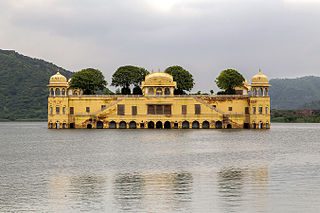Jal Mahal
Amer, Jaipur, Rajasthan – 302002
Jal Mahal (meaning “Water Palace”) is a palace located in the middle of the Man Sagar Lake in Jaipur city, the capital of the state of Rajasthan, India. The palace and the lake around it were renovated and enlarged in the 18th century by Maharaja Jai Singh II of Amber. “The Jal Mahal palace has got an eye-popping makeover. Traditional boat-makers from Vrindavan have crafted the Rajput style wooden boats. A gentle splashing of oars on the clear lake waters takes you to Jal Mahal. You move past decorated hallways and chambers on the first floor to climb all the way up to the fragrant Chameli Bagh. Across the lake, you can view the hills, dotted with temples and ancient forts, and on the other side, bustling Jaipur. The most remarkable change is in the lake itself. The drains were diverted, two million tonnes of toxic silt were dredged from the bottom, increasing its depth by over a metre, a water treatment system was developed, local vegetation and fish reintroduced, the surrounding wetlands regenerated and five nesting islands created to attract migratory birds.
Palace
The Jal Mahal palace is considered an architectural beauty built in the Rajput and Mughal styles of architecture (common in Rajasthan) providing a picturesque view of the lake (from the Man Sagar Dam on the eastern side of the lake that acts as a vantage point for viewing the lake and the valley), and the surrounding Nahargarh (abode of the tigers) hills. The palace, built in red sandstone, is a five storied building out of which four floors remain under water when the lake is full and the top floor is exposed. . The Chhatris on the four corners are octagonal. Rock exposures on the surface in some parts of the project area have also been utilised for constructing buildings. From the north east, the Kanak Vrindavan valley, where a temple complex is situated, the hills slope gently towards the lake edge. Within the lake area, the ground area is made up of a thick mantle of soil, blown sand and alluvium. On the terrace of the palace, a garden was built with arched passages. At each corner of this palace semi-octagonal towers were built with an elegant cupola. The restoration works done in the palace in the past (10–15 years back) were not satisfactory and an expert in the field of similar architectural restoration works of Rajasthan palaces carefully examined the designs that could decipher the originally existing designs on the walls, after removing the recent plaster work. Based on this finding, restoration works were redone with traditional materials for plastering. The plaster now used consisted of an organic material of a special mortar mix of lime, sand and surkhi mixed with jiggery, guggal and methi (Cummins) powder. It was also noticed that there was hardly any water seepage, except for a little dampness, in the floors below the water level. But the original garden, which existed on the terrace had been lost. Now, a new terrace is being created based on a similar roof garden existing on the Amer palace.
Visitor information
The Jal Mahal palace within the Maan Sagar Lake is accessible from the Jaipur-Delhi National Highway No 8, over a road distance of 4 kilometres (2.5 mi)) from Jaipur. Delhi is a further 273 kilometres (170 mi)) away. Jaipur city being centrally located in Rajasthan, the National Highway No.8 not only links to Delhi but also to Mumbai. NH No.11 is a road link of 366 kilometres (227 mi)) from Bikaner to Agra via Jaipur. The lake is 8 kilometres (5.0 mi)) from Amer palace on the Amber – Man Sagar Dam road to the north. The Jal Mahal palace is not open to visitors. But it was open to delegates at large on the occasion of Pravasi Bhartiya Divas held from 7-9 January, 2012 in Jaipur with the purpose of attracting investment for the restoration of the palace.
Source : Wikipedia
https://www.youtube.com/watch?v=2ec36HtllVo
Reviews



Rate this article